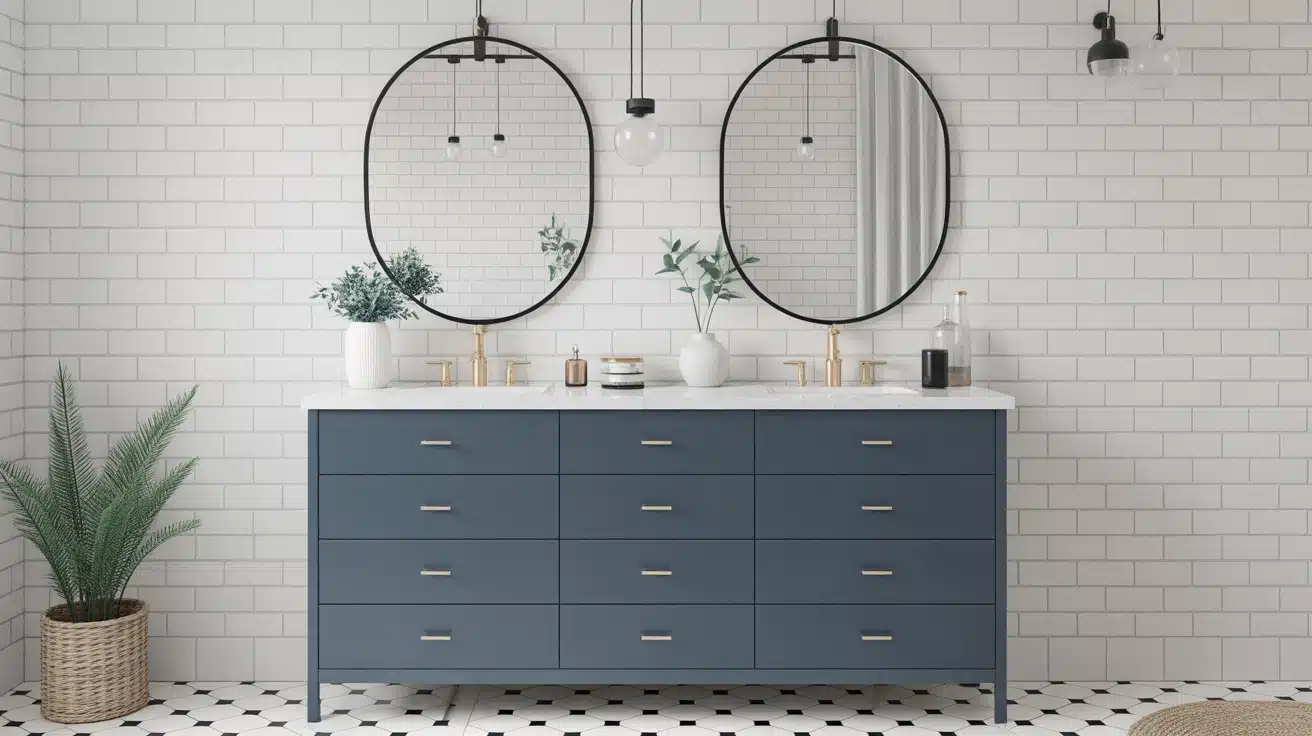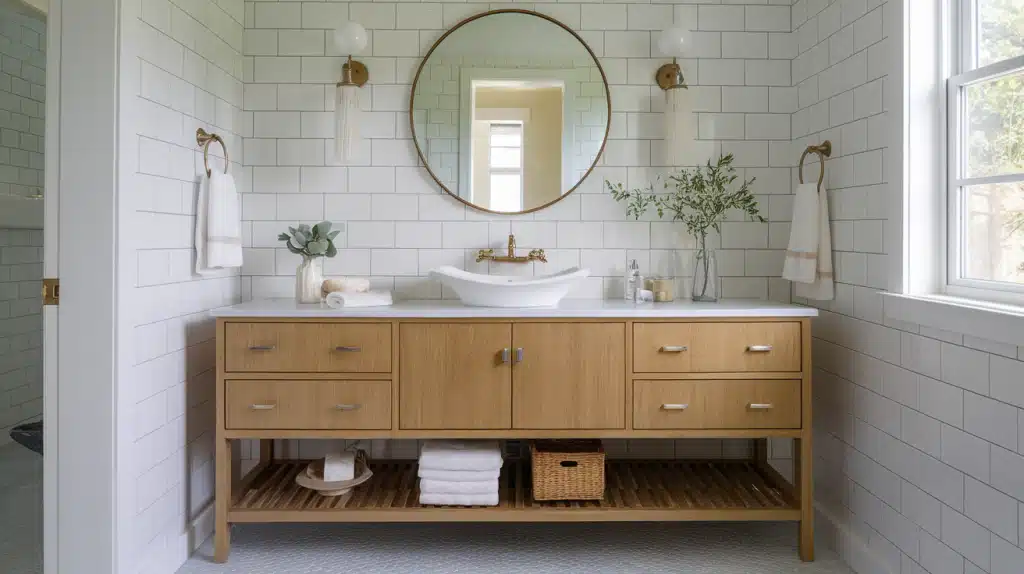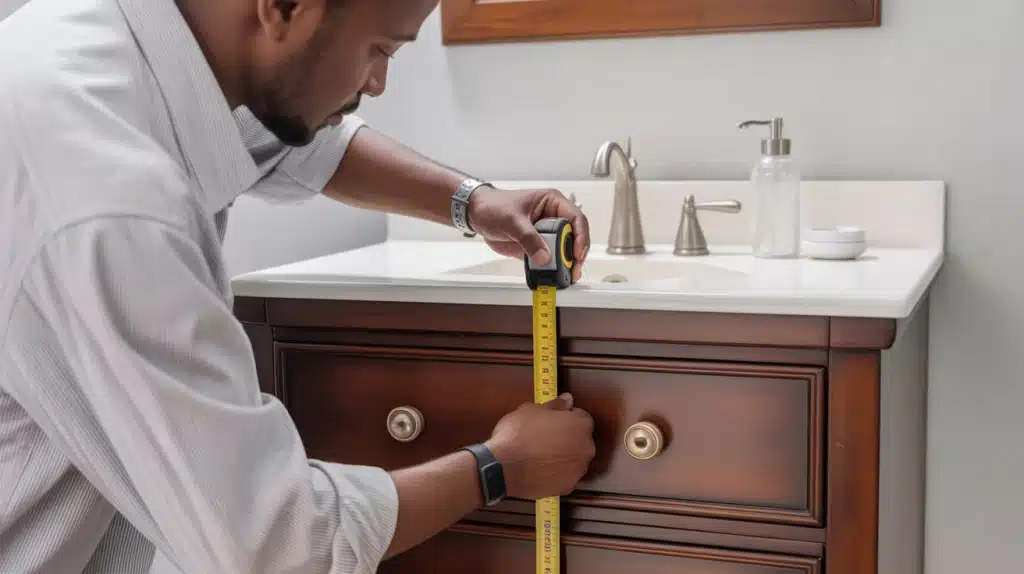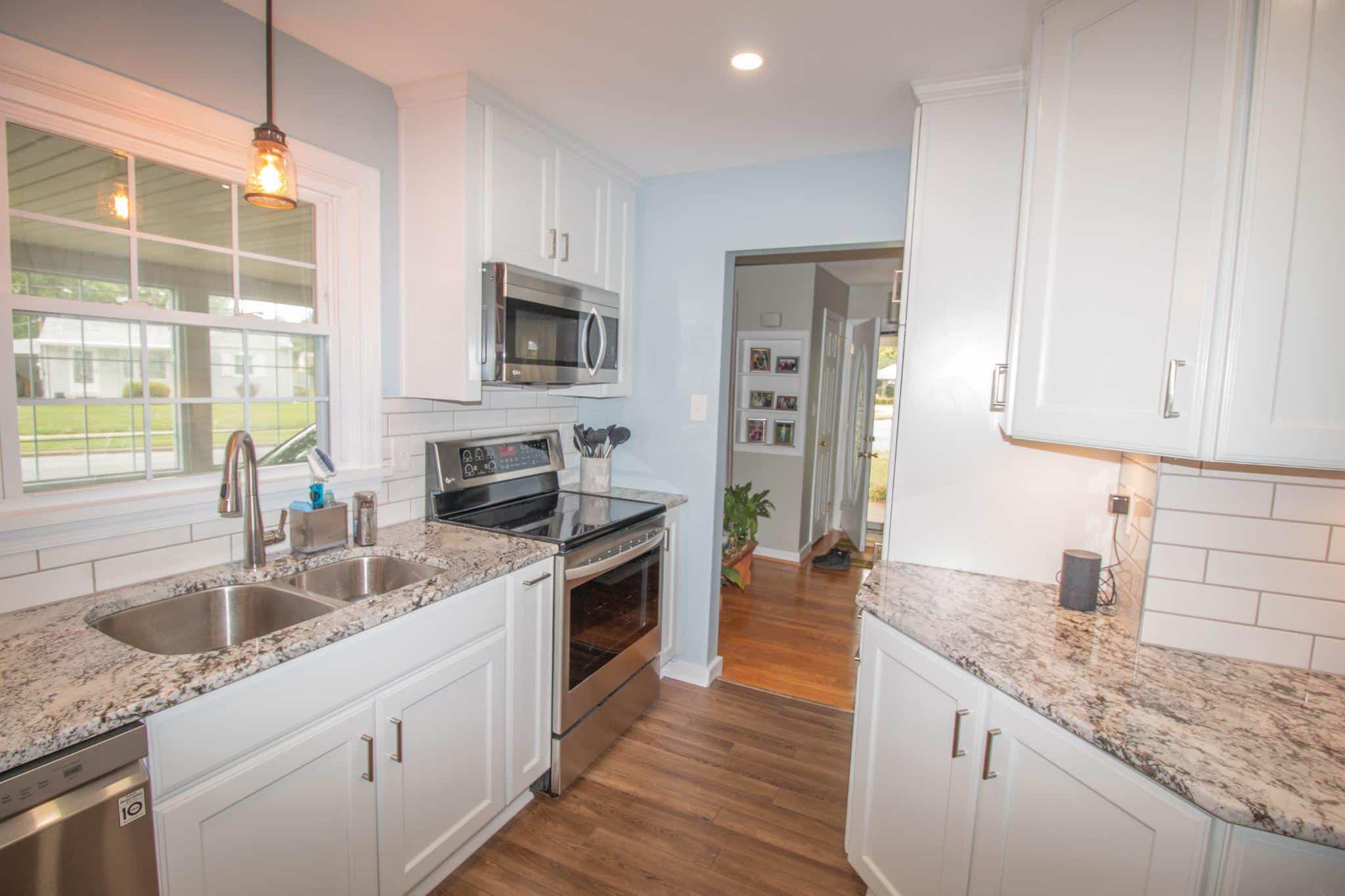Ever bent over too far to wash your hands or struggled to reach the faucet comfortably? The problem might be your vanity height.
Getting this measurement wrong affects your daily comfort and posture, and can lead to long-term back and neck issues. Your vanity height also impacts your bathroom’s overall look and functionality.
Vanity height standards have changed over the years. Older homes typically feature shorter designs around 30 inches, while today’s builds focus on comfort with taller options.
This guide covers everything you need to know: current industry standards, how to choose the right height for your household, and real tips from homeowners and professionals.
You’ll learn about standard measurements, comfort height options, and key factors like sink types and user needs that should guide your decision.
If you’re exploring creative ways to modify vanity height, consider turning a dresser into a vanity, which also gives you flexibility over the counter height.
What is the Standard Bathroom Vanity Height?
The current industry standard bathroom vanity height is 32 inches from the floor to the countertop.
This measurement strikes the right balance between usability and universal design, making it comfortable for most adults while still accessible for shorter users.
Remember that countertop height includes both the cabinet height plus the countertop thickness, so factor in that extra 1-2 inches when planning.
Evolution of Vanity Heights:
- Pre-1990s: Shorter vanities around 30 inches were the norm due to different design priorities and space constraints
- Modern homes: Taller vanities ranging from 34-36 inches have become preferred for better comfort and ergonomics
Bathroom Vanity Height Categories
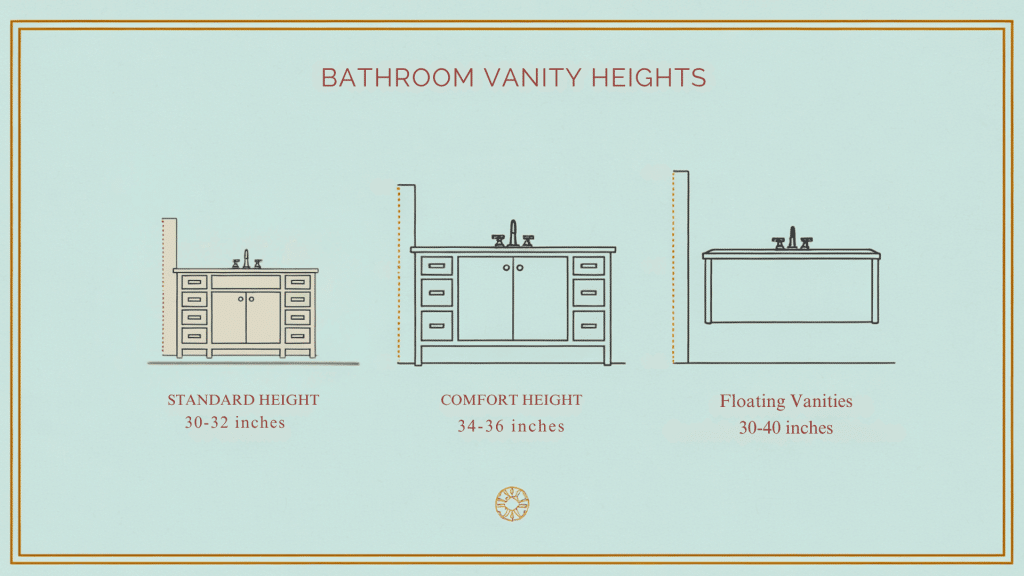
Bathroom vanity heights generally fall into three main categories: standard, comfort, and floating, each designed to suit different user needs, styles, and bathroom functions.
1. Standard Height (Traditional)
Height: 30-32 inches
This traditional height works well in older builds and family bathrooms where kids need easy access. You’ll find these heights common in homes built before the 2000s and in spaces designed with children in mind.
| Pros | Cons |
|---|---|
| Perfect for children to reach easily | Not comfortable for taller adults |
| Lower cost and wider selection | Can cause back strain during daily use |
| Fits standard plumbing setups | It may look outdated in modern designs |
2. Comfort Height (Adult-Friendly)
Height: 34-36 inches
This modern standard matches your kitchen counter height and provides better comfort for daily use. Most new construction uses this height in master bathrooms and adult-focused spaces.
| Pros | Cons |
|---|---|
| Better posture and less bending | Too high for small children |
| ADA-friendly for most adults | May require step stools for kids |
| Matches modern design trends | Slightly higher material costs |
3. Floating Vanities
Height: Custom (typically 30-40 inches)
Wall-mounted vanities offer complete height flexibility and work great in small spaces or modern bathrooms. You can install them at any height that works best for your household needs.
| Pros | Cons |
|---|---|
| Complete height customization | Requires strong wall support |
| Makes small bathrooms look bigger | More complex installation |
| Easy floor cleaning underneath | Limited storage compared to floor units |
Factors to Consider When Choosing Vanity Height
Selecting the right vanity height goes beyond following standards; it requires considering who will use it, the bathroom’s purpose, sink style, and accessibility needs.
1. User Height & Household Demographics
The height of your family members should guide your vanity choice. Taller adults over 5’8″ typically feel more comfortable with 34-36 inch vanities that reduce bending and back strain.
Families with young children often prefer lower heights around 30-32 inches for easy access. Consider installing dual vanities at different heights if you have mixed needs in your household.
2. Function of the Bathroom
Different bathrooms serve different purposes and should reflect that in their vanity height. Master bathrooms can use comfort height since they’re primarily for adults.
Powder rooms for guests work well with standard height as a middle ground. Kids’ bathrooms benefit from lower vanities that children can use safely without step stools.
3. Sink Type
Your sink choice directly impacts the final height of your bathroom setup. Vessel sinks sit on top of the countertop and add 4-6 inches to the total height, so you’ll need a shorter vanity (28-30 inches) to avoid an uncomfortably high setup.
Undermount and drop-in sinks work perfectly with standard vanity heights since they don’t add extra height above the counter.
4. Faucet Height & Reach
Faucet proportions matter for both function and looks. Taller faucets (8+ inches) pair better with lower sink setups to maintain proper reach and avoid splashing.
Standard height faucets work well with most vanity heights. Always check that your faucet can reach comfortably into the sink bowl without being too high or too low for daily use.
5. ADA Compliance
For wheelchair accessibility, specific measurements are required. The vanity height cannot exceed 34 inches, and you need at least 27 inches of clear space underneath for wheelchair access.
The sink should be no more than 6.5 inches deep, and faucets should be easy to operate with one hand. These requirements ensure the bathroom works for users with mobility needs.
How to Measure Bathroom Vanity Height Accurately
Accurate measurements ensure your vanity is both comfortable to use and visually balanced, preventing costly adjustments after installation.
Step 1: Measure from the finished floor to desired countertop height: Use a tape measure from your actual floor surface (not subflooring) to mark your ideal countertop height. This gives you the total height you’re working with for the entire vanity setup.
Step 2: Account for countertop thickness (usually 1-1.5 inches).: Subtract your countertop thickness from the total height to find your cabinet height. Most countertops add 1-1.5 inches, so a 32-inch total height needs a 30.5-inch cabinet.
Step 3: Consider sink bowl depth for vessel sinks: Vessel sinks add 4-6 inches above the counter, so subtract this from your desired total height. A vessel sink on a 28-inch vanity creates a comfortable 32-34-inch working height.
Step 4: Check wall clearance for cabinet doors and drawers: Measure the space behind your vanity to ensure doors and drawers can open fully. Most vanities need 2-3 inches of clearance from the wall for proper function.
Step 5: Plan mirror height so it aligns with vanity height: Position your mirror bottom edge 4-6 inches above the countertop for the best look and function. This creates a balanced appearance and prevents splashing on the mirror surface.
Forums and Discussion Boards on Standard Bathroom Vanity Height
Online renovation communities like GardenWeb, Houzz, and DIYChatroom are full of homeowners swapping tips about vanity height.
Many agree that while the old standard was 30–32 inches, modern builds often lean toward 34–36 inches for comfort, especially in master bathrooms.
Popular Forums and Discussion:
Master vs. Guest Bathroom Heights
“We went with the higher ‘comfort height’ vanities in our new build for all the baths with undermount sinks—even the 6 yr old’s bath … We opted for the standard height vanity in the powder room because of the added height of the vessel sink.”
Comfort Height or Regular for Bathroom Vanities?
Vessel Sink Height Lesson
“Tall vanity cabinets are now standard practice … Just a note on vessel sinks: the top of the sink should be 34″–36″ off the floor. If you have a vessel that sits 6″ above the counter, the cabinets should be lowered accordingly.”
Bathroom Vanity Height DiscussionVessel Sink Fit vs. Standard Vanity
“If choosing a vessel sink, you need the lower of the two standard vanity heights, which is 30″. The taller 36″ vanity height has become standard in any master suite … only with undermount or topmount sinks.”
Vessel Sink on 36″ Vanity Too High
Note: Forum opinions can be subjective and based on personal preferences or home layouts; always test heights in your own space before finalizing.
Choosing Between Different Vanity Heights
The right vanity height depends on who uses the bathroom most often and how it’s used. If you’re over 5’8″ and use the vanity daily, comfort height (34-36 inches) will save your back from strain.
Families with young children should stick with standard height (30-32 inches) or consider dual vanities at different heights.
For guest bathrooms, standard height works as a safe middle ground for all users. Remember that you can always add risers later to increase height, but lowering a vanity requires more work.
The Bottom Line
There’s no one-size-fits-all solution for bathroom vanity height – it depends on your comfort, household needs, and design goals.
The 32-inch standard works for most people, but comfort height (34-36 inches) offers better ergonomics for taller adults.
Consider your family’s height, the bathroom’s function, and your sink type when making this decision. Remember that small adjustments can make a big difference in daily comfort and long-term health.
Ready to find your perfect vanity height? Measure your space, try different heights with a temporary setup, and don’t forget to factor in your countertop thickness.
What vanity height works best in your home? Share your experience in the comments below!
Frequently Asked Questions
What Is the Trend Height of a Bathroom Vanity Now?
The current trend is 34-36 inches (comfort height) for modern homes, moving away from the traditional 30-32 inch standard.
Can a Bathroom Vanity Be 36 Inches High?
Yes, 36 inches is perfectly acceptable and popular for comfort height vanities, especially in master bathrooms for taller adults.
Is 35 Too High for a Bathroom Vanity?
No, 35 inches works well for most adults over 5’6″ and provides better ergonomics than standard height vanities.
What Is the Height Code for a Bathroom Vanity?
There’s no universal building code for vanity height, but ADA guidelines require a maximum of 34 inches for wheelchair accessibility.

